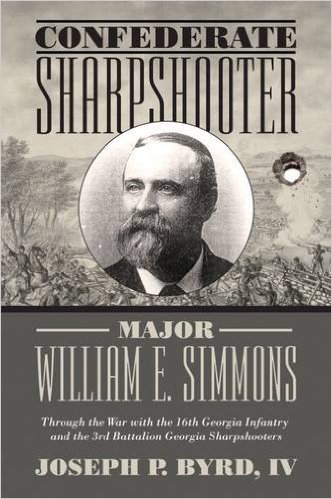Confederate Sharpshooter: Major William E. Simmons: Through the War with the 16th Georgia Infantry and the 3rd Battalion Georgia Sharpshooters by Joseph P. Byrd, IV. Mercer University Press, 2016. Cloth, ISBN: 978-0-88146-568-6. $35.00.
 Confederate Sharpshooter is a military biography of Major William E. Simmons, a rebel infantryman and sharpshooter who served in Gen. Lafayette McLaws’s (later Joseph B. Kershaw’s) division in the Army of Northern Virginia. Joseph P. Byrd, IV, an independent historian and Simmons’s great-great nephew, used the major’s personal diary, an unpublished biography (written in the 1960s by Simmons’s great nephew and law partner), and a number of published and archival sources to tell his ancestor’s story. It is clear that Byrd deeply admires Simmons’s character and achievements. While he did not aim to write a history of the military units in which his uncle served, he has largely succeeded in doing just that. In fact, it is surprising how infrequently Simmons appears in this book, as most of its quotations come from the major’s comrades, and most of its stories are about his regiment and battalion’s actions, not Maj. Simmons.
Confederate Sharpshooter is a military biography of Major William E. Simmons, a rebel infantryman and sharpshooter who served in Gen. Lafayette McLaws’s (later Joseph B. Kershaw’s) division in the Army of Northern Virginia. Joseph P. Byrd, IV, an independent historian and Simmons’s great-great nephew, used the major’s personal diary, an unpublished biography (written in the 1960s by Simmons’s great nephew and law partner), and a number of published and archival sources to tell his ancestor’s story. It is clear that Byrd deeply admires Simmons’s character and achievements. While he did not aim to write a history of the military units in which his uncle served, he has largely succeeded in doing just that. In fact, it is surprising how infrequently Simmons appears in this book, as most of its quotations come from the major’s comrades, and most of its stories are about his regiment and battalion’s actions, not Maj. Simmons.
Simmons’s early life was similar to other southern elites who came of age in the antebellum era. The son of a prominent lawyer in Lawrenceville, Georgia (northeast of Atlanta), he graduated from Emory College in 1858 and, at age eighteen, moved back home to edit and publish a newspaper. Although his father supported Stephen A. Douglas in the 1860 presidential election and eventually became a reluctant secessionist, Will (and his newspaper) enthusiastically endorsed John C. Breckenridge and became an early advocate for separation. In May 1861, Simmons enlisted in the Gwinnett Volunteers, a company that eventually mustered into the 16th Georgia Infantry Regiment. As an infantry lieutenant, Simmons fought at Malvern Hill, Crampton’s Gap (where he coolly led his company in a narrow escape), Antietam, and Fredericksburg.
In spring 1863, Simmons was chosen to serve in the newly created 3rd Georgia Sharpshooters Battalion. Ability, not seniority, led to membership in this elite group. Although the sharpshooters were skilled marksmen, long-range sniping was not their primary function. Rather, they were a light infantry battalion that conducted scouts, guarded pickets, and protected the army’s front and rear. As a sign of their distinction, these “trained skirmishers” were exempted from performing routine camp duties (80). Most historians will find Byrd’s description of Confederate sharpshooter battalions to be the most useful part of this book.
As a freshly minted sharpshooter, Simmons participated in the bloody engagements at Chancellorsville and Gettysburg, the siege of Chattanooga, and the failed assault on Fort Sanders (Knoxville) in November 1863. The following February, he convinced his fellow sharpshooters to reenlist for the remainder of the war and, two months later, he was promoted to the rank of major, though he did not learn of his advancement until after the protracted fighting of the 1864 Overland Campaign. When the 3rd Georgia’s ranking officer was wounded at Petersburg in July 1864, Simmons became the battalion’s acting commander. The following month, he led his troops to the Shenandoah Valley, where he was ultimately captured at the Battle of Guard Hill. Simmons was interred at Fort Delaware, the so-called “Andersonville of the North,” for the remainder of the war. While there, he proudly refused to take the oath of allegiance to the United States in exchange for his freedom because he would not, as the oath read, have done so “freely and voluntarily.” When Union authorities finally agreed to strike that clause in July 1865, Simmons and eighty-one other rebel officers swore loyalty and were released.
The last three chapters of Confederate Sharpshooter describe Simmons’s distinguished postwar career. Affectionately known as “the Major” for the rest of his life, Simmons became a successful attorney, Georgia state legislator, and longtime trustee at both the University of Georgia and Georgia Tech. Elected to the Georgia House of Representatives in 1870, he worked vigorously to rollback Republican Reconstruction in the state. A lifelong Democrat, Simmons was also a friend, admirer, and political opponent of the Populist Tom Watson.
Confederate Sharpshooter is a well-written book that recounts the operational details of an accomplished Confederate battalion and the exploits of one of its leaders. Byrd’s primary goal was to tell the story of a “truly remarkable man, his many accomplishments, and the people, places, and events that touched his life,” and he has largely succeeded in doing so (x). Unfortunately, Byrd all too frequently adopts the language and tone of his nineteenth-century subject: Simmons fought in the “War Between the States,” served with twenty-seven “Negro legislators” in the Georgia House (197), and “endured the pervasive humiliation of Reconstruction” (177). Moreover, as a state representative, he labored “to clean up the mess left by the Reconstruction government,” which included the “monumental task of reorganizing the government and unraveling all of the financial chicanery and plundering of the [Republican Gov. Rufus] Bullock administration” (182). Byrd’s take on his ancestor’s activities is unequivocally laudatory, but in most cases this seems justified. Simmons, though certainly a man of his time and place, accomplished much and was beloved by his peers.
David Schieffler is a Ph.D. candidate in the Department of History at the University of Arkansas.
